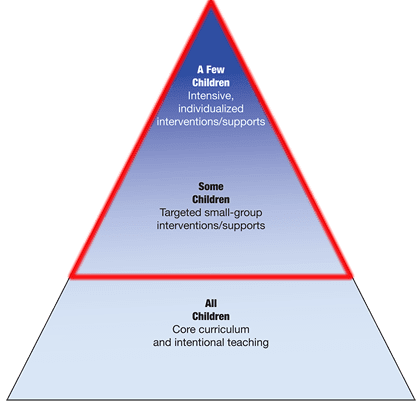
Academic Learning: Foundational Practices
Dialogic reading
Dialogic reading is an example of a foundational practice within tiered instruction. Dialogic reading is a specific type of interactive reading that relies on a set of strategies called PEER (Prompt- Evaluate-Expand-Repeat) designed to create a conversation with children and help them take an active role in storytelling. (To learn about dialogic reading practices, go to Module 6).
Video 7.15: Reading the book- Carrot Soup
A teacher reads to a group of young children using dialogic reading practices. (running time: 3 min. 33 sec.)
View transcript
Teacher:
“It was spring, Rabbit’s favorite season. It was time to plant the garden, order carrot seeds, and look forward to enjoying his favorite food, carrot soup. “ Rabbit’s favorite food is…
Child:
Carrot soup.
Teacher:
Everybody say it together.
Children:
Carrot soup.
Teacher:
Good. What is your favorite food?
Child:
Carrot soup.
Teacher:
Lily.
Child:
Noodles.
Teacher:
Noodles. Why are noodles your favorite food?
Child:
Well I just like them.
Teacher:
You like them? Ok. Kelsey what’s your favorite food?
Child:
All the foods in the whole wide world.
Teacher:
All the foods in the whole wide world! Oh my goodness. Brianna?
Child:
I like ‘ghetti and meatballs.
Teacher:
Spaghetti and meatballs. Why is that your favorite food?
Child:
Because I love it.
Teacher:
You love it. Ok, let’s see what rabbit is going to do next, with his carrots. Ready? “Rabbit ploughed and planted. Rabbit watered and weeded. He waited and waited and waited.” Why is Rabbit waiting?
Children:
[all talking at once] For the carrots. For the carrots to grow.
Teacher:
I’m looking for something. Ooh Alexis I see your hand. What is Rabbit waiting for?
Child:
The carrot soup.
Teacher:
He’s waiting for the carrot soup. He’s waiting for the carrot soup. I think there’s more to add. Diego, what else can you tell me.
Child:
I think he needs a special kind of plant food.
Teacher:
Special kind of plant food. What’s the plant food for?
Child:
Water. To grow.
Teacher:
To grow what?
Child:
The carrots.
Teacher:
That’s right. To grow the carrots. “Dog, someone has taken all of my carrots, said Rabbit. Have you seen them?”
Children:
It’s the cat!
Teacher:
What do you see?
Children:
The cat, the cat’s stealing them, the cat, the cat.
Teacher:
Christopher you’ve been sitting so quietly. What do you see?
Child:
The cat, the cat has them all.
Teacher:
How did the cat get the carrots?
Children:
[all talking at once] The cat pulled them up. The dog was away.
Teacher:
Christopher thinks the dog, the cat pulled them up. Lily says the dog was away. So which fish, which food did Duck say he likes better? Fish or carrots?
Children:
[all answering at once] Fish. Carrots. Fish. Fish.
Teacher:
Annie?
Child:
Fish.
Teacher:
Fish. Phillip, what did you say?
Child:
Fish.
Teacher:
Fish. So if Duck prefers fish to carrots, then the word ‘prefer’ must mean he likes one thing better than another, right? I prefer carrots to fish. I like carrots better. But Duck likes fish better. How many people like fish better than carrots? Show me your hands.
Child:
I like fish.
Teacher:
Fish? How many people like carrots better than fish?
Child:
Fish and carrots better.
Teacher:
How many people like Kelsey like fish and carrots?
Child:
I like both.
Teacher:
You like both. Everybody look at Rabbit’s face.
Children:
Sad.
Teacher:
Why does he feel that way? Alexis?
Child:
Because nobody was sharing the carrots with him.
Teacher:
Oh my goodness. And that makes him feel disappointed. Have you ever felt disappointed about anything? Show me a hand if you can tell me something the made you feel disappointed.

